The Economics and Statistics Division maintains archives of previous publications for accountability purposes, but makes no updates to keep these documents current with the latest data revisions from Statistics Canada. As a result, information in older documents may not be accurate. Please exercise caution when referring to older documents. For the latest information and historical data, please contact the individual listed to the right.
<--- Return to Archive
For additional information relating to this article, please contact:
August 05, 2022LABOUR MARKET TRENDS, JULY 2022 Labour force survey results reflect the period from July 10-16.
Ages 15+ (July 2022 vs June 2022, seasonally adjusted)
Nova Scotia's seasonally adjusted employment increased 1,600 (+0.3%) from June 2022 to 481,100 in July 2022.
The change in employment was attributable to higher part-time employment (+1,000) as well as a smaller gain in full-time employment (+600). These changes include variations in hours within the same job.
Nova Scotia’s labour force declined by 4,400 (-0.9%) to 511,100 in July 2022, pulling back from the all-time high established last month.
With rising employment stable and falling labour force, Nova Scotia's unemployment rate declined from 7.0% in June 2022 to 5.9% in July 2022. This is the lowest unemployment rate in monthly labour force survey records dating back to 1976, though lower unemployment rates were recorded in the early 1970s.
Nova Scotia's labour force participation rate was down 0.7 percentage points to 60.8% in July 2022. The employment rate was stabled at 57.2% in July 2022.
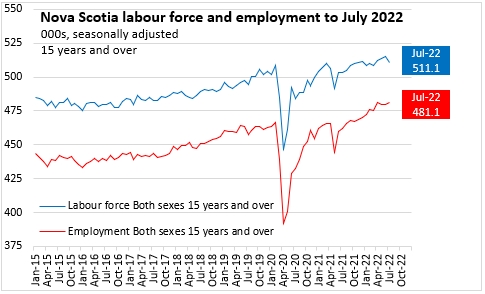

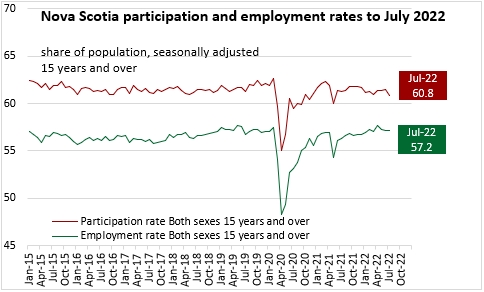
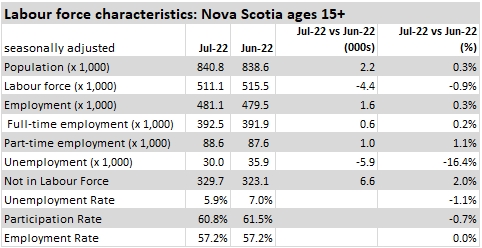
Ages 15+ (July 2022 vs July 2021, seasonally adjusted)
In July of 2021, Nova Scotia was coming out of tighter restrictions that had generated significant employment loss in May of that year. Compared with July of 2021, Nova Scotia's population over the age of 15 had increased by 20,300 while the labour force grew by 7,800 and employment increased by 19,200. The unemployment rate decreased by 2.3 percentage points while the participation rate fell by 0.5 percentage points. The employment rate increased by 0.9 percentage points.
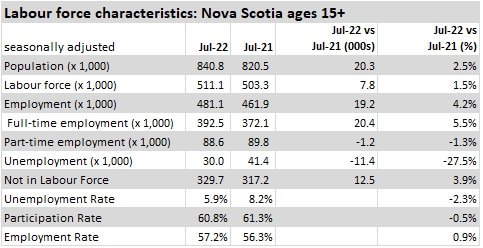
Ages 15+ (January-July 2022 vs January-July 2021, seasonally adjusted)
Compared with the first seven months of 2021, Nova Scotia's population has averaged 16,700 higher for January to July of 2022. The labour force was up by 7,600 and employment increased by 17,500. The unemployment rate decreased by 2.0 percentage points (though this rounds down to 6.5% for January-July 2022) while the participation rate declined by 0.3 percentage points. The employment rate increased by 1.0 percentage points.
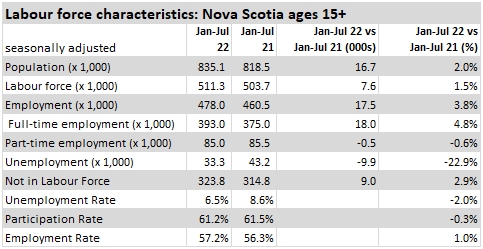
Age Cohorts (July 2022 vs June 2022, seasonally adjusted)
Among youth (ages 15-24), employment increased by 2,400 (+3.7%) while the labour force decreased by 2,500 (-3.3%). Because employment increased while labour force contracted, the youth unemployment rate fell to 7.4%, which is the lowest youth unemployment rate in the monthly labour force survey records dating back to 1976. The previous low in youth unemployment rate was 9.3% in January of 2022. The contraction in the youth labour force reduced youth participation rates by 2.4 percentage points to 66.3% while the rise in employment lifted youth employment rates 2.1 percentage points to 61.5%.
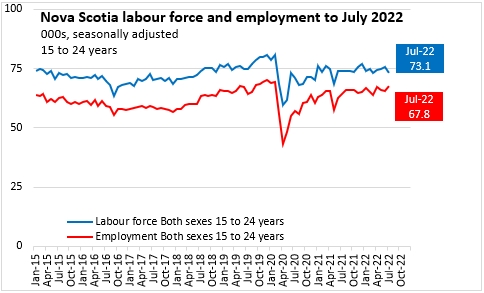
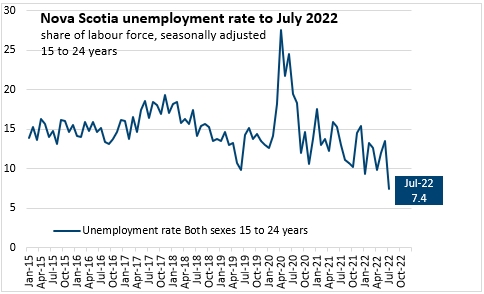
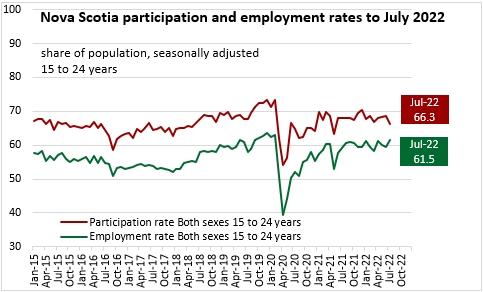
The population aged 25-54 makes up the largest part of the labour force. In the core age group, employment decreased by 1,700 (-0.6%) and the labour force declined by 2,100 (-0.7%). Because labour force decline was slightly faster than employment, the core aged unemployment rate edged down 0.1 percentage points to 5.5% in July. The core aged participation rate fell by 1.0 percentage points to 85.4% while the core aged employment rate decreased 0.7 percentage points to 80.8%.
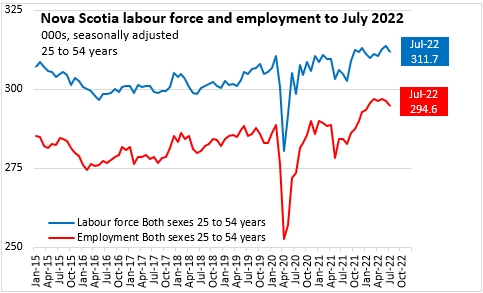
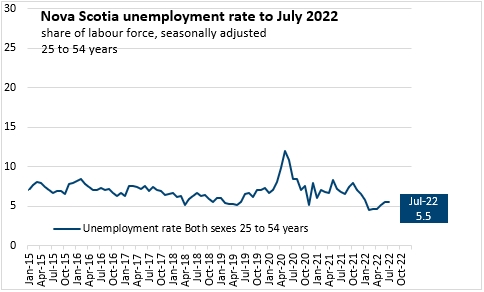
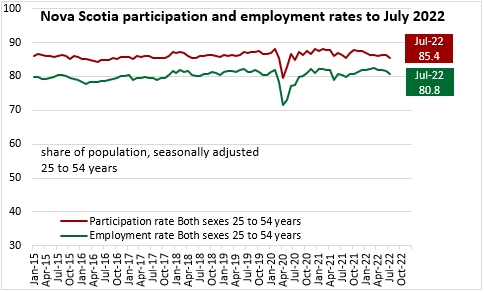
Older workers (aged 55+) reported increases for both labour force (+200 or +0.2%) and employment (+900 or +0.8%). Since the percentage increase in employment was faster than in labour force, the older worker unemployment rate fell 0.7 percentage points to 5.9%. The older worker participation rate was unchanged at 34.5% and the employment rate for older workers increased 0.2 percentage points to 32.5%.
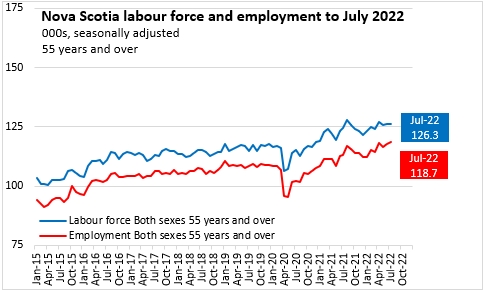

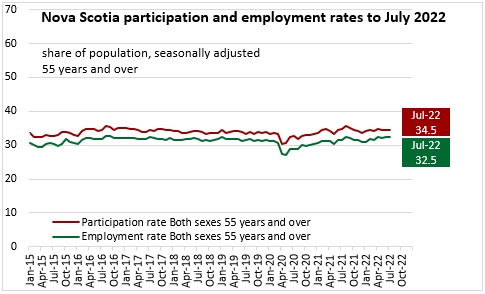
Males and Females (Ages 15+, July 2022 vs June 2022, seasonally adjusted)
The monthly employment change reflected a gain among males (+2,500 or +1.0%), partially offset by falling employment among females (-900 or -0.4%). The male labour force contracted by 3,600 (-1.4%) while female labour force declined by 800 (-0.3%).
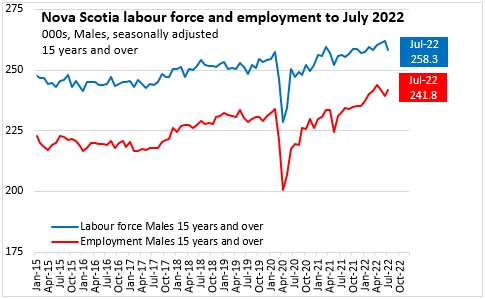
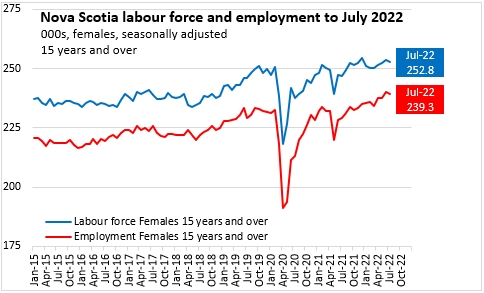
The male unemployment rate fell by 2.2 percentage points to 6.4% as employment grew while labour force contracted. The female unemployment rate was unchanged at 5.3% in July 2022 as employment and labour force contracted at a similar pace.

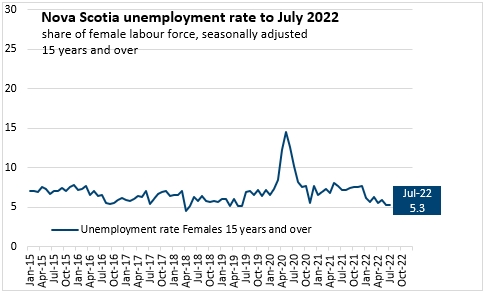
With a notable decline in labour force, male participation rates fell by 1.1 percentage points to 63.5% in July 2022. Female participation rates were down 0.4 percentage points to 58.2%. The employment rate for males was up 0.5 percentage points to 59.5% while the female employment rate was down 0.4 percentage points to 55.1%.
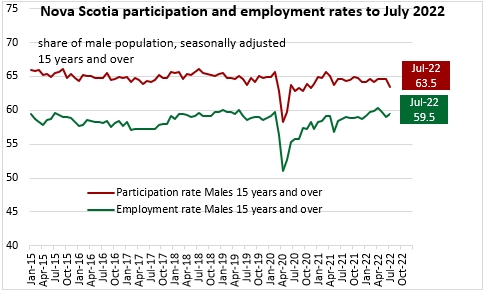
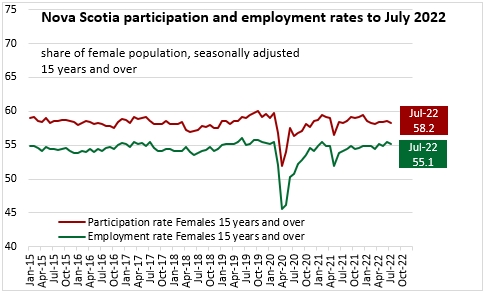
Overall, last month's employment gains were concentrated among youth and males while there were notable employment declines among core aged workers as well as women. The labour force contraction was also concentrated among youth and males, with no substantial offsetting gains among other cohorts.
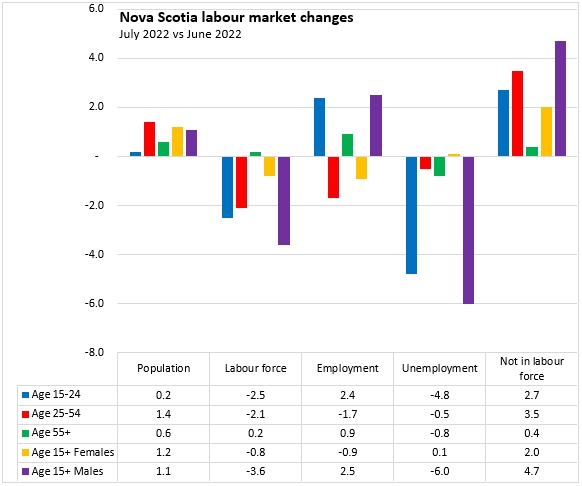
Age and sex cohorts (July 2022 vs July 2021, seasonally adjusted)
Compared with July 2021, the latest month's labour force growth was concentrated among core aged and female workers (only youth reported a decline in labour force). Employment gains over the last year were widespread across cohorts, but faster for core-aged workers (consistent with that cohort's larger population increase). Although unemployment fell for all cohorts, it fell by more for males. Male employment growth was strong, but there was less of an increase in labour force and a larger increase in males not in the labour force.
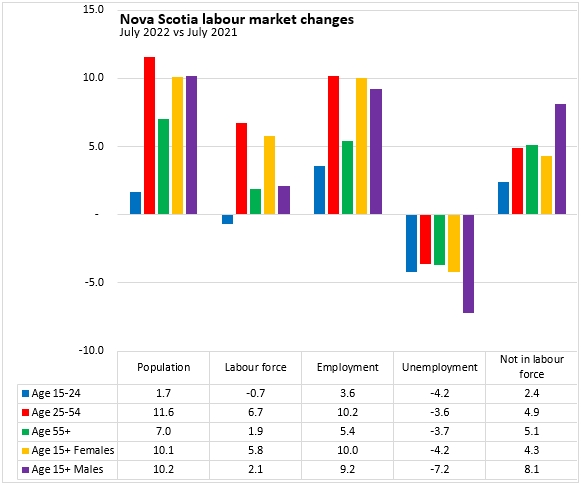
Age and sex cohorts (January-June 2022 vs January-June 2021, seasonally adjusted)
On average over the first seven months of 2022, employment and labour force gains were reported in each age cohort, though growth among youth was more modest while employment growth for males outpaced female employment gains.
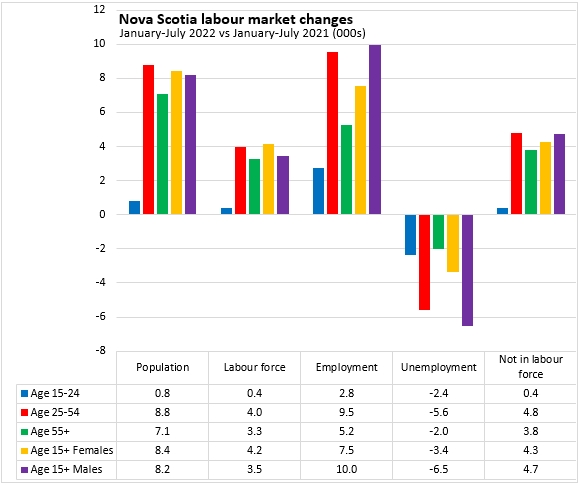
Class of Worker (July 2022 vs June 2022, seasonally adjusted)
The July 2022 employment change reflected gains for private sector employees (+3,100 or +1.0%) and self-employment (+100 or +0.2%) while public sector employment contracted (-1,700 or -1.3%) to partially offset the gains.

Class of Worker (July 2022 vs July 2021, seasonally adjusted)
Compared July 2021, there were substantial gains in employment for private sector workers (+11,700 or +4.1%), public sector workers (+9,800 or +8.4%) while self employment was down (-2,300 or -4.0%).
Industry of Employment (July 2022 vs June 2022, seasonally adjusted)
The employment change from June to July reflected notable employment declines in transportation, accommodation/food, public administration, finance/insurance/real estate and agriculture. There were notable gains in employment for manufacturing, wholesale/retail information/culture/recreation and construction.
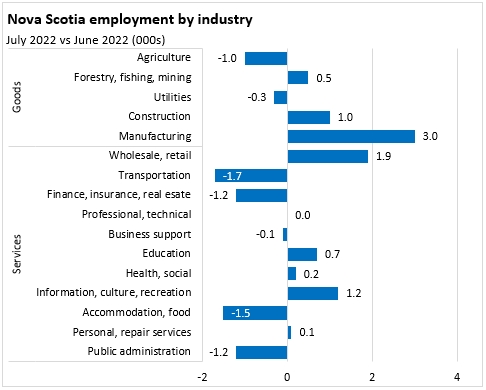
Industry of Employment (July 2022 vs July 2021, seasonally adjusted)
Over the last 12 months, employment has risen across almost all industries with the exceptions of agriculture, forestry/fishing/mining, wholesale/retail, business support (including call centres) and public administration. The largest employment gains were in construction and professional/technical services.
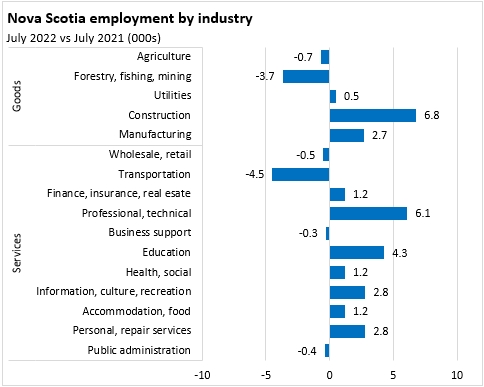
Industry of Employment (January-July 2022 vs January-July 2021, seasonally adjusted)
On average over the first seven months of 2022 (compared with the same period last year), most industries reported employment gains. The increase in year-to-date average employment was fastest for professional/technical services, health/social (including daycare) and construction. Only agriculture, forestry/fishing/mining and transportation reported declining employment on average in 2022.

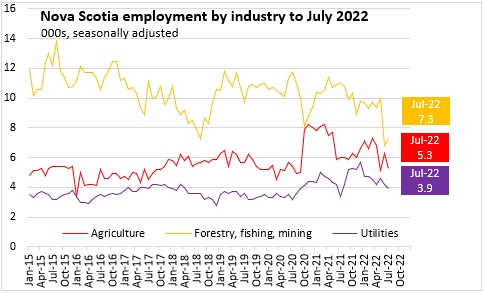
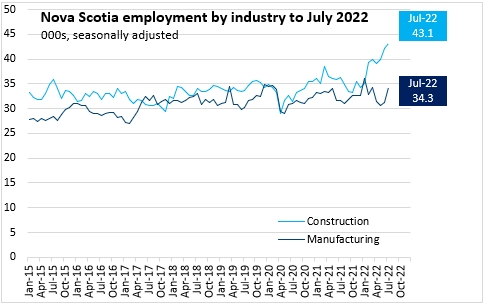
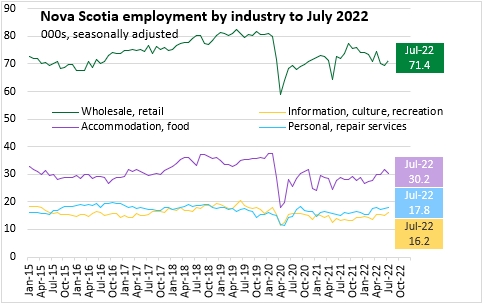

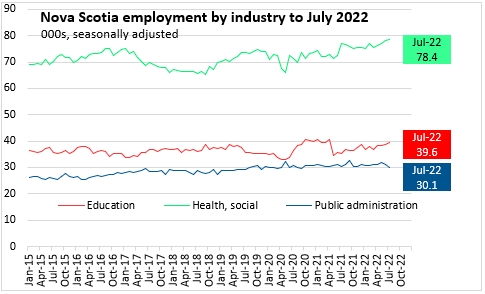
Hours worked and employment (January-July 2022 vs January-July 2021, unadjusted)
Changes in unadjusted hours worked show different variations than changes in seasonally adjusted employment (comparing the average over the first seven months of 2022 with the same period in 2021). Overall employment was up by 3.8% while hours were up by 3.7%.
The only year-to-date contractions in employment were in agriculture, forestry/fishing/mining and transportation. However, only forestry/fishing/mining reported fewer hours worked. The year-to-date increases in employment were strongest in professional and technical services as well as in business support (call centres). In these industries, hours worked grew even faster than employment.
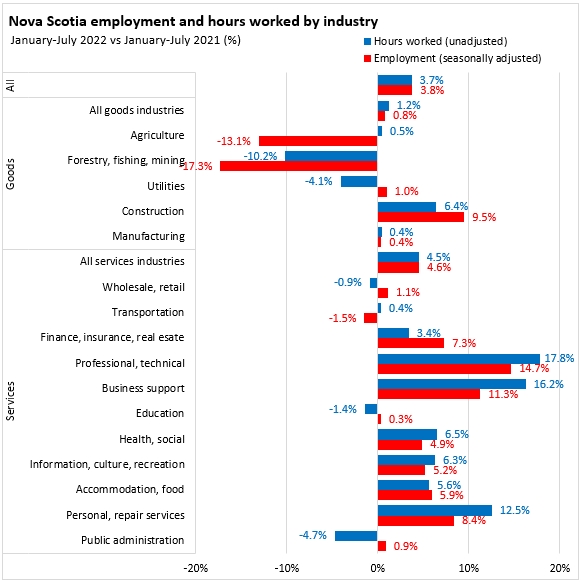
Average weekly earnings (unadjusted, both full time and part time, January-July 2022 vs January-July 2021)
Average weekly earnings increased by 4.1% from January-July 2021 to January-July 2022. Earnings were up by across most industries, with the exceptions of wholesale/retail trade, information/culture/recreation and public administration. The fastest gains in average weekly earnings were in forestry/fishing/mining, professional and technical services and business support (which includes call centres).

Average weekly earnings across all employees were $1,001.27 in July 2022. The highest average weekly earnings (both full and part time employees) were reported in forestry/fishing/mining, utilities, professional/technical services and public administration. The lowest average weekly earnings were in accommodation/food, wholesale/retail and agriculture.
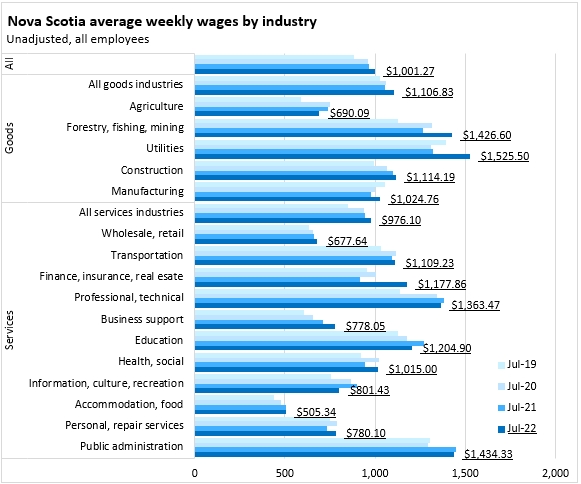
Regions (July 2022 vs July 2021, unadjusted 3 month moving average)
Compared with July 2021, employment and labour force each increased in Halifax, Cape Breton and Annapolis Valley while each decreased in the North Shore and Southern Nova Scotia regions. The unemployment rate declined in Cape Breton, Halifax and the Annapolis Valley where employment gains all outpaced labour force growth. Unemployment rates went up in the North Shore and Southern Nova Scotia economic regions where the decline in employment was larger than the decline in labour force.
Participation rates were up in Cape Breton, the Annapolis Valley and Halifax but down in the North Shore and Southern Nova Scotia economic regions. The same pattern holds for employment rates: up for Cape Breton, the Annapolis Valley and Halifax and down for the North Shore and Southern Nova Scotia.
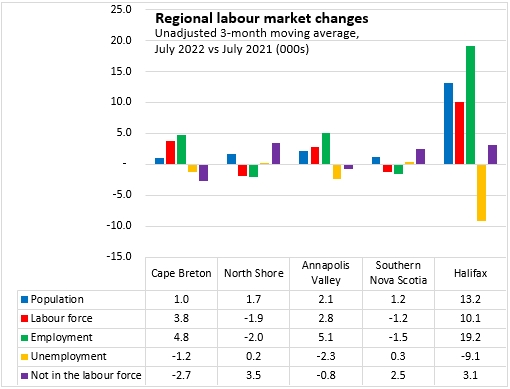

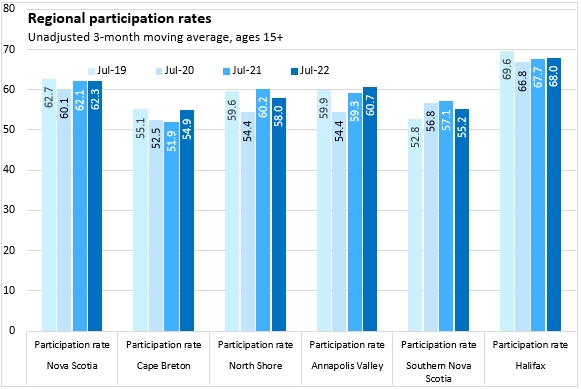
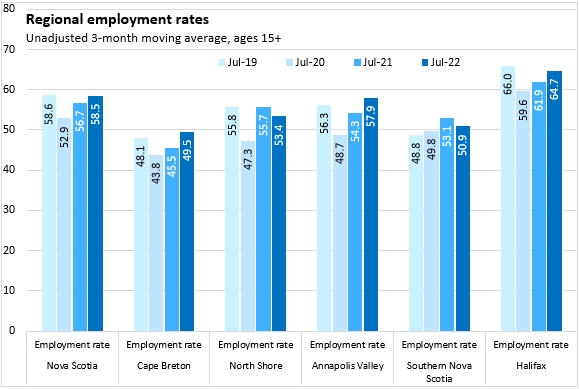
Regions (January-July 2022 vs January-July 2021, unadjusted 3 month moving average)
Comparing the average over the first seven months of 2022 with the same months of 2021, labour force was down for the North Shore and Southern Nova Scotia economic regions. Labour force grew in Cape Breton, the Annapolis Valley and Halifax. Employment was up for Cape Breton, the Annapolis Valley and Halifax while there were declines in the North Shore and Southern Nova Scotia regions.
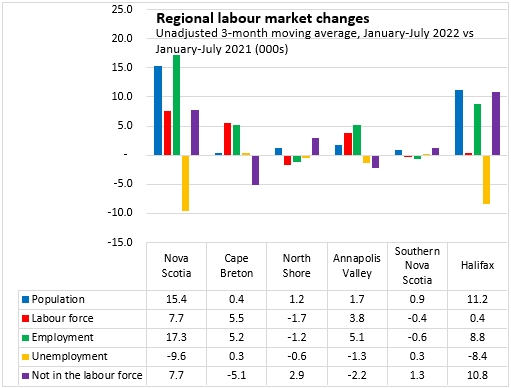
Provincial Comparisons (July 2022 vs June 2022, seasonally adjusted)
Canada's employment decreased by 30,600 (-0.2%) from June to July, a second consecutive month of decline. Most provinces reported insignificant changes in employment, though the declines in Prince Edward Island and Ontario were more significant.
The labour force contracted slightly for Canada (-0.1%) with declines in all provinces except New Brunswick, Manitoba and British Columbia. The largest decreases in labour force were reported in Prince Edward Island and Nova Scotia.
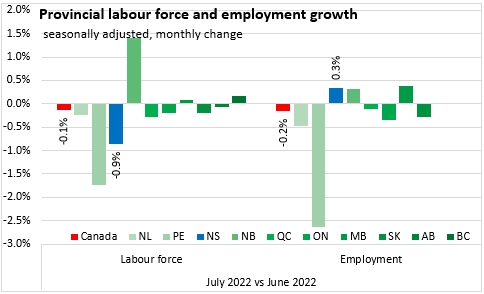
Provincial Comparisons (July 2022 vs July 2021, seasonally adjusted)
Compared with July 2021, Nova Scotia's employment was up 4.2% while labour force expanded by 1.5%. National employment was up 3.6% while labour force increased by 0.9%. All provinces reported employment gains over this period with the fastest growth in Prince Edward Island and the slowest in Quebec. Labour force was up for nine provinces, led by Prince Edward Island. Only New Brunswick reported a lower labour force.
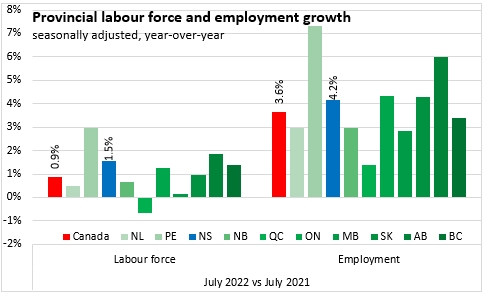
The national unemployment rate was 4.9% in July 2022, unchanged from June 2022 and down from 7.4% in July 2021. This maintained the record low unemployment rate for Canada in the monthly Labour Force Survey results that started in 1976. Manitoba, Saskatchewan and Quebec had the lowest unemployment rates while Newfoundland and Labrador reported the highest unemployment rate at 10.2%.
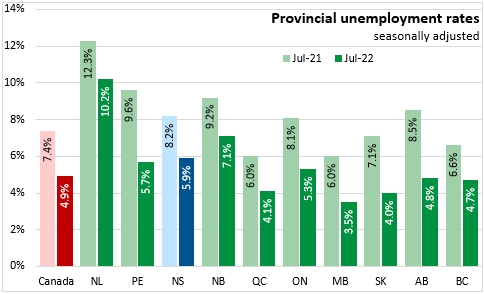
The national participation rate was 64.7% in July 2022. The highest participation rates were in Saskatchewan and Alberta while the lowest was in Newfoundland and Labrador.

The national employment rate was 61.6% in July 2022. Alberta reported the highest employment rate while Newfoundland and Labrador reported the lowest.

Census Metropolitan Areas (July 2022, seasonally adjusted 3 month moving average)
The Halifax unemployment rate was 4.9% in the seasonally adjusted July 2022 three month moving average. This was similar to other Census Metropolitan Areas, but lower than in the rest of Nova Scotia (8.2%). In central and western provinces, unemployment rates in Census Metropolitan Areas are similar to or higher than unemployment rates outside CMAs. In the Atlantic Provinces unemployment rates are higher outside CMAs.
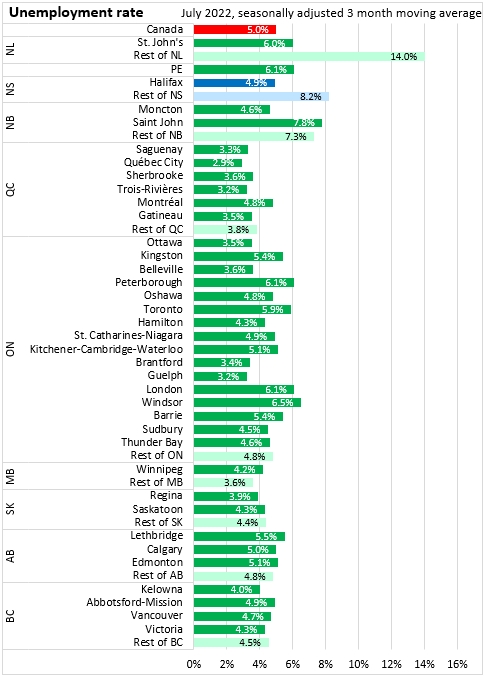
Halifax's participation rate was 67.8% in the seasonally adjusted July 2022 three month moving average while participation rates were 55.4% across the rest of the province.

Halifax reported an employment rate of 64.5% in the seasonally adjusted July 2022 three month moving average while the employment rate was 50.8% outside the city.

Sources: Statistics Canada. Table 14-10-0036-01 Actual hours worked by industry, monthly, unadjusted for seasonality; Table 14-10-0063-01 Employee wages by industry, monthly, unadjusted for seasonality; Table 14-10-0287-01 Labour force characteristics, monthly, seasonally adjusted and trend-cycle, last 5 months; Table 14-10-0380-01 Labour force characteristics, three-month moving average, seasonally adjusted; Table 14-10-0387-01 Labour force characteristics, three-month moving average, unadjusted for seasonality, last 5 months; Table 14-10-0355-01 Employment by industry, monthly, seasonally adjusted and unadjusted, and trend-cycle, last 5 months (x 1,000); Table 14-10-0288-01 Employment by class of worker, monthly, seasonally adjusted and unadjusted, last 5 months (x 1,000); Table: 14-10-0380-02 Labour force characteristics, three month moving average, seasonally adjusted (x 1,000)
<--- Return to Archive